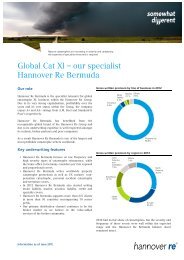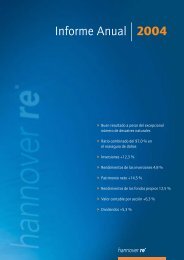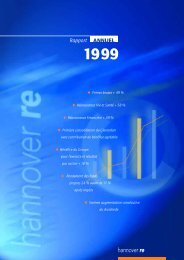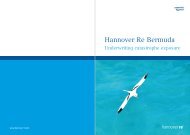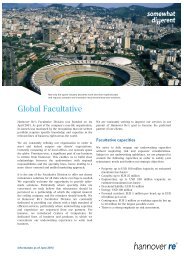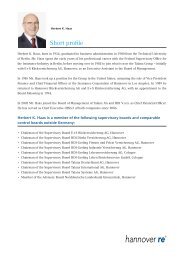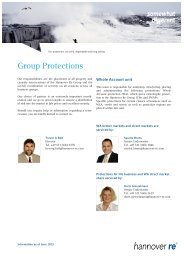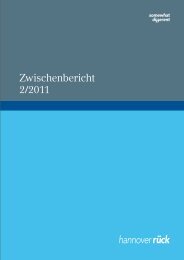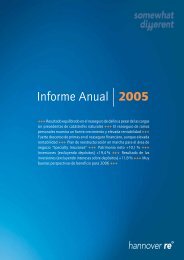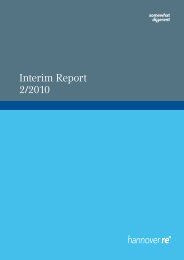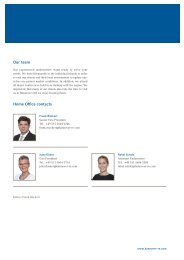Annual Report 2010 - Hannover Re
Annual Report 2010 - Hannover Re
Annual Report 2010 - Hannover Re
You also want an ePaper? Increase the reach of your titles
YUMPU automatically turns print PDFs into web optimized ePapers that Google loves.
Development of deferred acquisition costs in EUR thousand <strong>2010</strong> 2009<br />
Net book value at 31 December of the previous year 1,838,450 1,860,783<br />
Currency translation at 1 January 114,743 40,977<br />
Balance at 1 January of the year under review 1,953,193 1,901,760<br />
Additions 438,858 418,512<br />
Amortisations 567,165 478,066<br />
Portfolio entries/exits 626 3<br />
<strong>Re</strong>classification pursuant to IFRS 5 (3) –<br />
Currency translation at 31 December 8,987 (3,759)<br />
Net book value at 31 December of the year under review 1,834,496 1,838,450<br />
For further explanatory remarks please see Section 3.2 “Summary<br />
of major accounting policies”.<br />
The age structure of the accounts receivable which were unadjusted<br />
but considered overdue as at the balance sheet date<br />
is presented below.<br />
Age structure of overdue accounts receivable<br />
in EUR thousand<br />
Three months<br />
to one year<br />
<strong>2010</strong> 2009<br />
More than one year<br />
Three months<br />
to one year<br />
More than one year<br />
Accounts receivable 61,366 87,605 52,642 98,826<br />
Within the scope of our management of receivables we expect<br />
to receive payment of accounts receivable within three<br />
months of the date of creation of the debit entry – a period<br />
for which we also make allowance in our risk analysis. Please<br />
see our comments on the credit risk within the risk report on<br />
page 66 et seq.<br />
The default risks associated with accounts receivable under<br />
reinsurance business are determined and recognised on the<br />
basis of case-by-case analysis.<br />
The value adjustments on accounts receivable that we recognise<br />
in adjustment accounts changed as follows in the year<br />
under review:<br />
Value adjustments on accounts receivable in EUR thousand <strong>2010</strong> 2009<br />
Changes in value adjustments<br />
Cumulative value adjustments at 31 December of the previous year 72,258 125,573<br />
Currency translation at 1 January of the year under review 2,325 (2,351)<br />
Cumulative value adjustments after currency translation 74,583 123,222<br />
Value adjustments in the year under review 11,025 23,718<br />
<strong>Re</strong>versal 38,375 74,682<br />
<strong>Re</strong>classification pursuant to IFRS 5 (11,465) –<br />
Cumulative value adjustments at 31 December of the year under review 35,768 72,258<br />
Notes<br />
Gross book value of accounts receivable at 31 December of the year under review 2,877,071 2,942,132<br />
Value adjustments 35,768 72,258<br />
Net book value of accounts receivable at 31 December of the year under review 2,841,303 2,869,874<br />
In addition, we took specific value adjustments on reinsurance<br />
recoverables on unpaid claims in the year under review.<br />
We would refer the reader to the corresponding remarks on<br />
the loss and loss adjustment expense reserve in Section 5.7<br />
“Technical provisions”.<br />
With regard to the credit risks resulting from technical assets<br />
we would also refer the reader to our comments in the risk<br />
report on page 66.<br />
<strong>Hannover</strong> <strong>Re</strong> Group annual report <strong>2010</strong><br />
5.4 technical assets Notes<br />
147



